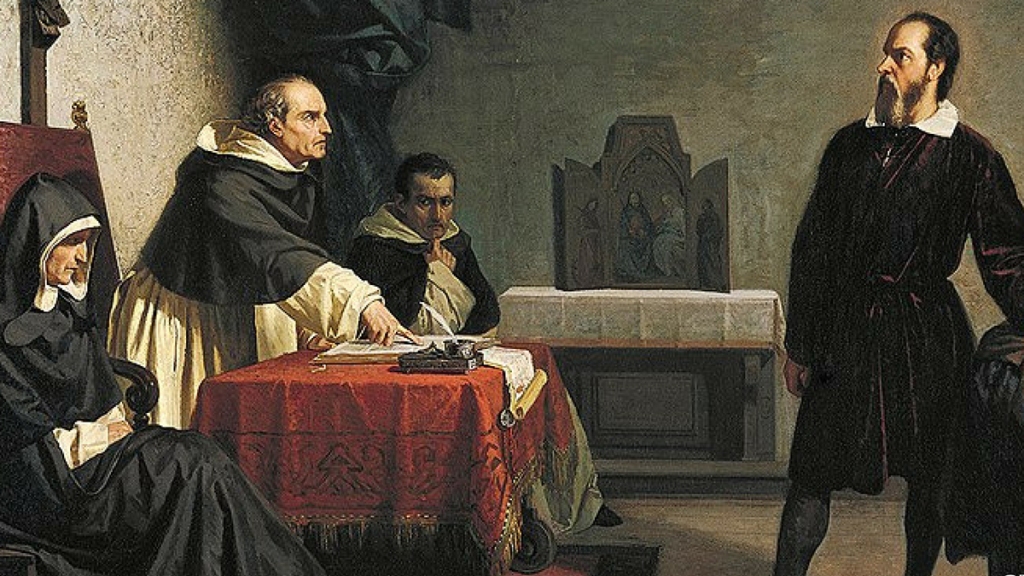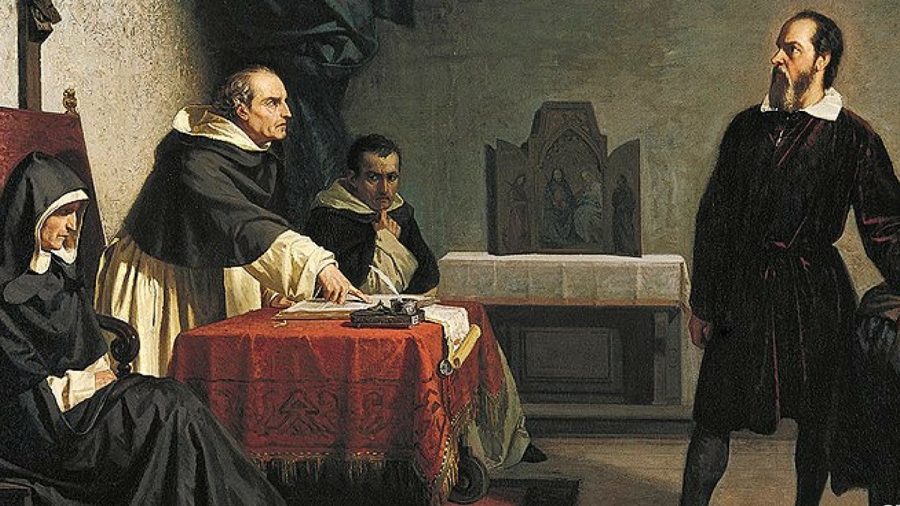Science & Religion as Incommensurable Worlds.

“The intention of the Holy Spirit is to teach us how one goes to heaven, not how heaven goes” – Galileo Galilei
On receiving his Mendel Medal, Nobel Prize winner Peter Doherty remarked that he “had no quarrel with” its citation for demonstrating that “between true science and true religion there is no intrinsic conflict”.
Doherty’s “high sentiments” seem at odds with conventional wisdom. Certain polemicists try to give the impression that science is a hotbed of virulent atheism (in fact, scientists are pretty evenly split on religious belief). It’s also true that for nearly half a millennium, science and religion – here meaning specifically the Christian religion – have been locked in a tar-baby-like conflict, with religion usually the loser – although doggedly refusing to give in.
But is Doherty right? Is there no intrinsic conflict between science and religion? The answer is both yes and no.
The trial for heresy of Galileo Galilei is the go-to case for those who dogmatically insist that conflict is intrinsic – and religion the inevitable loser. Yet Galileo himself denied any such conflict. To Galileo, science and religion belonged to entirely different realms of human experience. To science belonged the quest to understand the physical world, while the proper role of religion was “the service of God and the salvation of souls”. To Galileo, each of these was a kind of truth, and as “one truth cannot contradict another”, there the matter was settled.
The Church famously disagreed, 350 years ago – as have scientists like Richard Dawkins and Daniel Dennett in recent decades. Of course, each disagreed for different reasons, but their conclusion was the same: science and religion are inevitably in conflict. More recently, biologist Stephen J Gould attempted a truce with his Non-Overlapping Magisteria (NOMA) thesis. But Gould met as little success as Galileo. It seems that both sides of the conflict just want a fight and are ever-eager to launch cross-border raids on each other.
So the conflict between religion and science seems as likely to be settled as peace in the Middle East. But there may indeed be a solution, in Thomas Kuhn’s “incommensurability” thesis.
Kuhn, whose The Structure of Scientific Revolutions is one of the key works in the philosophy of science, did not develop the notion of incommensurability with the clash of science and religion in mind at all. Rather, his concern was competing paradigms of science. Worse, Kuhn’s notion of incommensurability in Structure was notoriously slippery. Yet, as later developed by Kuhn and also by philosophers like Hilary Putnam, it may be seen that incommensurability shows that science and religion need not conflict, not so much because they are compatible, but because they are incommensurable.
Galileo was, in fact, on the right track.
Noting that the Bible scarcely discusses astronomical phenomena at all, he extended that to science as a whole. “It follows as a necessary consequence,” he wrote. “That, since the Holy Ghost did not intend to teach us whether Heaven moves or stands still … then so much the less was it intended to settle for us any other conclusion of the same kind”. Galileo further cited Church fathers such as St Augustine and St Jerome to argue that it is directly contrary to the purpose of the Bible and the intention of the Church founders, and thus by extension to the religious purpose, to use Holy Scripture to settle scientific disputes.
Galileo advocated a method of justifying scientific knowledge grounded in experiment and reason. His method of justifying religious truth, on the other hand, is very different. Religious truth, Galileo argued, is mandated by the authority of the Holy Spirit, as revealed in the Bible: “the primary purpose of the sacred writings … is the service of God and the salvation of souls”. Galileo underscores the authority of the Bible by asserting that it “can never speak untruth whenever its true meaning is understood”.
Yet, despite Galileo’s dismissal of Biblical astronomy, the fact remains that the Bible does make statements about the natural world which appear to directly contradict those of science. How could Galileo reconcile that with his assertion that the Bible can never speak untruth? Again, he quotes Augustine and other church fathers to caution about understanding what is meant in Biblical passages, warning that it “may say things which are quite different from what its bare words signify”.
It must also be borne in mind that Christian orthodoxy does not assert that the Bible is the literal word of God. Unlike, say, Islam, Christian tradition does not claim that God directly dictated his word to the prophets. Instead, Christianity argues that the Bible is “inspired” (literally, “breathed in”) by God and transmitted through – fallible – human agents, “according to the judgment of those times in which they were acted”, St. Jerome says, “rather than according to the truth contained”.
In other words, the Bible describes the earth as flat, and the universe as geocentric, because that was all its audience could understand and it was more important to save their souls than give them a science lesson they couldn’t digest anyway. “The sacred authors accommodate[d] themselves[…]more to accepted usage than to the true essence of things”, Galileo says.
The result, as Galileo says, are Biblical passages that at least appear to contradict demonstrated scientific truth. Opponents of religion would argue that that makes the Bible wholly useless. Yet, as Kuhn wrote, scientific texts are no less prone to becoming outdated. “Reading an out-of-date scientific text”, he wrote, “[One] characteristically encounters passages that make no sense.”
But, Galileo argued, the scientifically-nonsensical passages of the Bible could yet speak truth to another realm of human experience. “Nobody will deny that [the Bible] is often very abstruse”, he admits, but its truth is justified by manner in which it satisfies the spiritual experience of humanity – which is not the same as its epistemic experience.
This is what Kuhn describes as the incommensurability of differing paradigms.
I’ll discuss the concept of incommensurability in the second part of this article.

Pingback: When Two Truths Go to War Pt 2 – A Devil's Curmudgeon